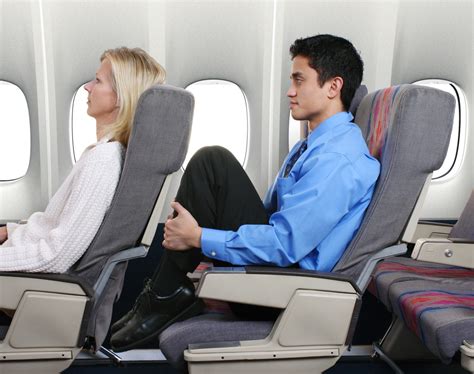
Reclining your airplane seat could soon come with a financial penalty, as airlines are exploring stricter enforcement of existing rules and implementing new technologies to manage passenger comfort and prevent in-flight disturbances. The move comes amid increasing passenger frustration and incidents related to reclining seats, prompting a re-evaluation of onboard etiquette and airline policies.
Airlines are considering various methods to address the controversial issue of seat reclining, ranging from imposing fines for excessive reclining to introducing seat designs that limit or eliminate the reclining function altogether. The increased scrutiny stems from a rise in reported disputes between passengers, some of which have escalated into confrontations requiring intervention from flight attendants and, in some cases, law enforcement upon arrival.
The potential fines are part of a broader effort to curb disruptive passenger behavior, which has seen a significant increase in recent years. “The issue of reclining seats has been a long-standing source of tension among passengers,” stated a representative from the International Air Transport Association (IATA), who wished to remain anonymous, “and airlines are now seeking more effective ways to manage these conflicts.”
One of the proposed solutions involves implementing a “recline button etiquette” system, where passengers would be encouraged to communicate with the person behind them before reclining their seat. Failure to do so, or reclining excessively after a request not to, could result in a warning, followed by a fine if the behavior persists. The fines, according to preliminary discussions, could range from $25 to $100, depending on the severity of the infraction and the airline’s specific policy.
Airlines are also exploring technological solutions, such as sensors embedded in seats to monitor the degree of recline and alert flight attendants to potential conflicts. Another concept being considered is the use of “smart seats” that allow passengers to control the recline of the seat in front of them, promoting a more collaborative approach to seat adjustments.
The debate over reclining seats highlights the challenges airlines face in balancing passenger comfort with the limited space available in aircraft cabins. As air travel becomes increasingly crowded, the issue is likely to remain a contentious one, requiring innovative solutions and clear communication to ensure a more pleasant flying experience for everyone.
The move to potentially fine passengers for reclining their seats excessively or without consideration for the passenger behind them represents a significant shift in airline policy, reflecting growing concerns about passenger behavior and the need for more effective conflict resolution strategies in the confined space of an aircraft cabin. Airlines are grappling with the challenge of balancing passenger comfort and personal space, while also maintaining order and preventing disruptions during flights. The proposed fines are just one element of a multi-faceted approach that includes technological solutions, revised seat designs, and enhanced crew training to address the issue.
The increased attention on reclining seats is driven by a number of factors, including rising passenger volumes, shrinking seat sizes, and a growing sense of entitlement among some travelers. As airlines seek to maximize revenue by squeezing more seats into each aircraft, the available personal space for each passenger has diminished, leading to increased friction and discomfort. The issue is further compounded by the fact that passengers have different expectations and tolerances when it comes to seat reclining, with some viewing it as a basic right and others considering it an inconsiderate act.
“The airline industry is facing a perfect storm of factors that are contributing to the reclining seat controversy,” said travel expert Sarah Miller, “Passengers are more stressed and anxious about flying than ever before, and the lack of space and comfort on many flights only exacerbates these feelings. Airlines need to find ways to address these issues proactively, rather than simply reacting to incidents after they occur.”
One of the main arguments against reclining seats is that it significantly reduces the legroom and personal space of the passenger behind, making it difficult to work, eat, or even move comfortably. Passengers who are tall or have limited mobility are particularly affected by reclining seats, as the reduced space can cause discomfort and even pain. On the other hand, proponents of reclining argue that it is a legitimate way to improve comfort during long flights and that passengers should have the right to use the features of their seat as they see fit.
The debate over reclining seats has also raised questions about the role of airlines in managing passenger behavior and enforcing etiquette rules. While airlines have always had the authority to address disruptive conduct, such as fighting or intoxication, they have traditionally been reluctant to intervene in disputes over reclining seats, viewing them as minor disagreements that passengers should resolve themselves. However, the increasing frequency and severity of these incidents have forced airlines to reconsider their approach and take a more proactive role in maintaining order and preventing conflicts.
The proposed fines for excessive reclining are intended to serve as a deterrent and send a message that inconsiderate behavior will not be tolerated. However, some critics argue that fines are not the best solution and that airlines should focus on other measures, such as improving seat designs, providing more legroom, or offering alternative seating options. Others suggest that airlines should focus on educating passengers about etiquette and encouraging them to communicate respectfully with each other.
In addition to the potential fines, airlines are also exploring other ways to address the reclining seat issue. Some airlines are considering installing “pre-reclined” seats, which have a fixed recline angle that cannot be adjusted by the passenger. This option would eliminate the possibility of conflict over reclining seats but may also reduce passenger comfort. Another option is to offer seats with more legroom or adjustable headrests, which could improve comfort without requiring passengers to recline their seats.
Airlines are also investing in technology to help manage passenger comfort and prevent disputes. Some airlines are using sensors to monitor seat positions and alert flight attendants to potential conflicts. Others are developing apps that allow passengers to communicate with each other anonymously and resolve issues without involving the crew.
The issue of reclining seats is not unique to the airline industry. Similar debates have taken place in other forms of transportation, such as buses and trains, where passengers have limited space and different expectations about comfort. The challenge for transportation providers is to find solutions that balance the needs and preferences of all passengers and create a more pleasant travel experience for everyone.
The implementation of fines for reclining seats, if adopted, would likely be accompanied by a clear set of guidelines and enforcement procedures. Airlines would need to define what constitutes “excessive” reclining and establish a fair process for investigating and resolving disputes. Passengers would also need to be informed about the new rules and the potential consequences of violating them.
The success of any new policy on reclining seats will depend on a number of factors, including the clarity of the rules, the fairness of the enforcement process, and the willingness of passengers to comply. It will also require a collaborative effort from airlines, passengers, and crew to create a more respectful and considerate environment on board.
The move towards stricter policies on seat reclining reflects a broader trend in the airline industry towards greater regulation of passenger behavior. In recent years, airlines have faced a growing number of incidents involving unruly or disruptive passengers, ranging from verbal abuse to physical assaults. These incidents have not only disrupted flights but have also posed a safety risk to passengers and crew.
In response to this trend, airlines have implemented stricter rules and penalties for disruptive behavior, including fines, bans from future flights, and even criminal charges. They have also invested in training for flight attendants to help them de-escalate conflicts and manage difficult passengers.
The increased focus on passenger behavior is driven by a number of factors, including rising passenger volumes, increased stress and anxiety among travelers, and the proliferation of social media, which has made it easier for passengers to share their experiences and complaints. Airlines are also under pressure from regulators and law enforcement agencies to maintain order and safety on board.
The implementation of fines for reclining seats is just one example of how airlines are seeking to address the challenges of managing passenger behavior in the increasingly crowded and stressful environment of air travel. While the move may be controversial, it reflects a growing recognition that airlines need to take a more proactive role in ensuring a safe and pleasant flying experience for everyone.
Ultimately, the issue of reclining seats highlights the need for greater communication and understanding among passengers. By being mindful of each other’s needs and preferences, and by communicating respectfully, passengers can help to create a more positive and harmonious travel experience for everyone. The airline industry’s response, whether through fines or other means, underscores the increasing pressure to foster a more considerate environment in the skies.
The potential for fines also raises concerns about enforceability and the possibility of false accusations. Airlines will need to establish clear procedures for investigating complaints and ensuring that passengers are not unfairly penalized. This might include requiring photographic or video evidence, or relying on the testimony of multiple witnesses. The lack of clarity could lead to more disputes and further complicate the already tense atmosphere on some flights.
The introduction of fines for reclining seats could also have unintended consequences, such as encouraging passengers to engage in other forms of disruptive behavior, or creating a sense of resentment and animosity towards airlines. It is important for airlines to carefully consider the potential impact of their policies and to communicate them clearly and transparently to passengers.
Furthermore, the focus on reclining seats could distract from other important issues related to passenger comfort and safety, such as the lack of legroom, the quality of food and beverages, and the availability of in-flight entertainment. Airlines need to take a holistic approach to improving the passenger experience, rather than simply focusing on one particular issue.
The debate over reclining seats is likely to continue for the foreseeable future, as there is no easy solution that will satisfy everyone. However, by engaging in open and honest dialogue, and by exploring innovative solutions, airlines and passengers can work together to create a more pleasant and respectful flying experience for all.
The move to penalize reclining also opens the door to questions about the airline’s responsibility to provide adequate space and comfort. If passengers are being fined for utilizing a feature that infringes on another’s space, should airlines be compelled to increase seat pitch or offer alternatives for those willing to pay for more room? This raises broader issues about the economics of air travel and the trade-offs between affordability and comfort.
“This situation highlights the ongoing tension between airlines’ desire to maximize profits and passengers’ expectations for a comfortable and respectful flying experience,” commented travel industry analyst John Davis. “Ultimately, a long-term solution will require a more comprehensive approach that addresses the underlying issues of limited space and varying passenger needs.”
The impact of such a policy on passengers with disabilities or medical conditions also needs consideration. Some individuals may require reclining for medical reasons, and airlines will need to establish clear guidelines for accommodating these needs without penalizing them. This could involve providing documentation from a physician or requesting advance notice to ensure appropriate accommodations can be made.
Moreover, the implementation of fines may disproportionately affect passengers traveling in economy class, where space is already limited. Business and first-class passengers typically have more legroom and reclining space, making them less likely to be impacted by the new policy. This could further exacerbate the perception of inequality in air travel and create additional resentment among economy class passengers.
The debate over reclining seats also raises questions about the role of technology in mediating passenger disputes. Some airlines are experimenting with virtual reality (VR) headsets that allow passengers to create their own personal space and block out distractions. While VR technology is still in its early stages, it could potentially offer a solution to the problem of limited space and varying comfort preferences on flights.
Ultimately, the success of any new policy on reclining seats will depend on the willingness of airlines to engage in open and transparent communication with passengers. Airlines need to clearly explain the rationale behind the policy, the procedures for enforcement, and the steps they are taking to address the underlying issues of limited space and varying passenger needs.
The future of air travel is likely to involve a combination of technological innovations, policy changes, and enhanced communication to create a more pleasant and respectful experience for all passengers. The issue of reclining seats is just one example of the challenges and opportunities that lie ahead.
The potential impact on family travel also needs to be considered. Families traveling with young children may rely on reclining seats to help their children sleep or stay comfortable during long flights. Airlines will need to ensure that their policies do not unfairly penalize families who are simply trying to manage the needs of their children. This could involve providing designated family seating areas or offering flexible reclining options for families traveling with young children.
The broader implications for passenger rights also warrant attention. Some advocacy groups argue that fining passengers for reclining their seats is a violation of their basic rights and that airlines should instead focus on providing more comfortable and spacious seating options. These groups are calling for greater transparency and accountability from airlines and for stronger regulations to protect passenger rights.
The evolving landscape of air travel also includes the rise of low-cost carriers, which often offer even less legroom and fewer amenities than traditional airlines. The implementation of fines for reclining seats could disproportionately affect passengers traveling on these low-cost carriers, who may already be facing cramped conditions and limited personal space.
The debate over reclining seats is a complex and multifaceted issue that requires careful consideration of the needs and perspectives of all stakeholders. Airlines need to balance the desire to maximize profits with the need to provide a safe, comfortable, and respectful flying experience for all passengers. Passengers, in turn, need to be mindful of the impact of their actions on others and to communicate respectfully with each other and with airline staff.
The implementation of a new policy on reclining seats could also have implications for the training of flight attendants. Flight attendants will need to be trained to effectively enforce the new rules, to de-escalate conflicts between passengers, and to provide assistance to passengers with disabilities or medical conditions. This will require additional training and resources for flight attendants, as well as clear guidelines for handling disputes and enforcing the new policy.
The long-term impact on passenger satisfaction and airline loyalty also needs to be considered. If passengers feel that they are being unfairly penalized or that their rights are being violated, they may be less likely to fly with that airline in the future. Airlines need to carefully weigh the potential benefits of implementing fines for reclining seats against the potential risks to passenger satisfaction and loyalty.
The move toward fines for reclining also highlights the growing tension between personal freedom and communal consideration in public spaces. As populations grow and spaces become more crowded, the need for etiquette and self-regulation becomes increasingly important. The debate over reclining seats is just one example of how these tensions are playing out in the context of modern air travel.
Ultimately, the solution to the reclining seat controversy will require a combination of policy changes, technological innovations, and enhanced communication. Airlines need to be proactive in addressing the underlying issues of limited space and varying passenger needs, while passengers need to be mindful of the impact of their actions on others and to communicate respectfully with each other and with airline staff. Only through a collaborative effort can we create a more pleasant and respectful flying experience for all.
The legal ramifications of implementing such fines are also worth exploring. Could passengers challenge the fines in court? Would airlines need to amend their contracts of carriage to explicitly allow for such penalties? These legal questions could potentially delay or complicate the implementation of the policy.
In conclusion, the potential for airlines to fine passengers for reclining their seats represents a significant development in the ongoing debate over passenger comfort and behavior in air travel. While the move aims to address the increasing number of disputes and disruptions related to reclining seats, it also raises a number of complex questions about fairness, enforceability, and the overall passenger experience. Airlines will need to carefully consider these issues and engage in open and transparent communication with passengers to ensure that any new policy is implemented effectively and fairly.
Frequently Asked Questions (FAQ)
1. Why are airlines considering fining passengers for reclining their seats?
Airlines are exploring this option due to an increase in passenger disputes and confrontations over reclining seats. The limited space in aircraft cabins, coupled with differing passenger expectations about comfort, has led to heightened tensions and a growing number of incidents requiring intervention from flight attendants. “The issue of reclining seats has been a long-standing source of tension among passengers,” according to an IATA representative, and airlines are seeking more effective ways to manage these conflicts. The potential fines aim to deter inconsiderate behavior and promote a more respectful onboard environment.
2. How much could the fines for reclining seats be?
According to preliminary discussions, the fines could range from $25 to $100, depending on the severity of the infraction and the airline’s specific policy. The fine amount would likely be determined by factors such as the degree of recline, whether the passenger communicated with the person behind them before reclining, and whether the reclining occurred after a request not to do so. However, it’s important to note that these are just potential figures and the actual fines could vary depending on the airline and the specific circumstances.
3. How would airlines enforce a policy of fining passengers for reclining?
Enforcement would likely involve a combination of factors, including reports from other passengers, observations by flight attendants, and possibly technological solutions such as sensors in seats to monitor the degree of recline. Airlines would need to establish clear procedures for investigating complaints and ensuring that passengers are not unfairly penalized. This might include requiring photographic or video evidence, or relying on the testimony of multiple witnesses. The lack of clarity could lead to more disputes and further complicate the already tense atmosphere on some flights. A “recline button etiquette” system, where passengers are encouraged to communicate with the person behind them before reclining, may also be implemented.
4. Are there any exceptions to the reclining seat fine policy?
It is likely that there would be exceptions for passengers with disabilities or medical conditions who require reclining for comfort or health reasons. Airlines would need to establish clear guidelines for accommodating these needs without penalizing them. This could involve providing documentation from a physician or requesting advance notice to ensure appropriate accommodations can be made. Airlines would also need to consider the needs of families traveling with young children who may rely on reclining seats to help their children sleep or stay comfortable during long flights.
5. What are some alternative solutions to the reclining seat problem besides fines?
Airlines are exploring several alternative solutions, including:
- Pre-reclined seats: These seats have a fixed recline angle that cannot be adjusted by the passenger, eliminating the possibility of conflict.
- Seats with more legroom: Offering seats with more legroom or adjustable headrests can improve comfort without requiring passengers to recline their seats.
- Technological solutions: Some airlines are using sensors to monitor seat positions and alert flight attendants to potential conflicts, while others are developing apps that allow passengers to communicate with each other anonymously.
- Improved communication: Encouraging passengers to communicate respectfully with each other about reclining preferences.
- Increased seat pitch: Airlines could increase the distance between rows of seats to provide more legroom for all passengers.
- Virtual Reality (VR) Headsets: Allowing passengers to create their own personal space and block out distractions.









